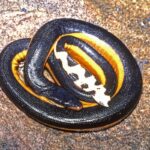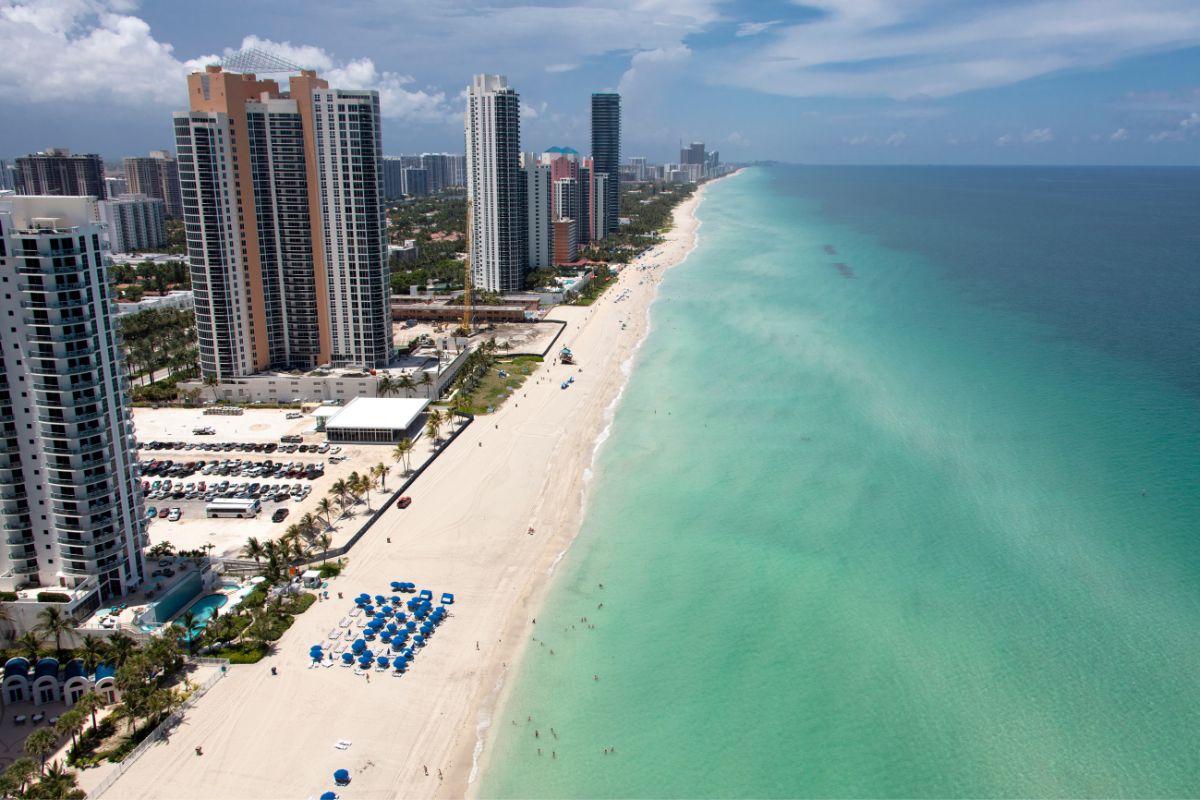Spain is a gorgeous country to visit with its beautiful beaches, fabulous culture, and dense history. Having said that, it is very important to make sure that you are prepared for everything before you travel.
Have you considered that there may be snakes in Spain? If so, are you aware of their whereabouts and whether they are poisonous?
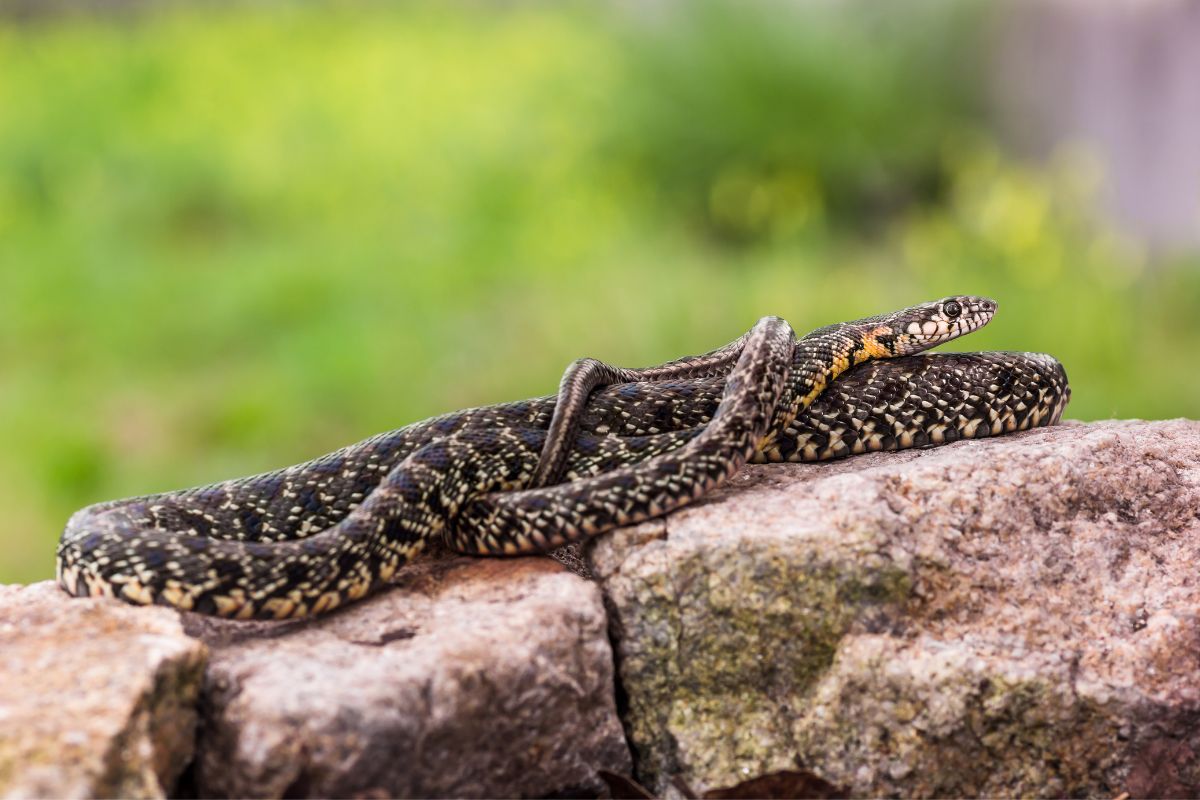
If you’re planning a trip to Spain, this article will give you all the information you need on snakes in Spain, giving you the peace of mind to enjoy yourself on the trip without the concern of being bitten by a snake. Let’s dive in!
Are There Snakes In Spain?
Before you start worrying, it is very important to note that if you are staying in a resort, a city or a popular area in Spain, snakes are nothing to worry about.
While there are some snakes in Spain, they are not commonly seen. They would only be something to worry about if you are venturing off the beaten track.
The weather in Spain does appeal to snakes, as the perfect habitat for snakes to survive in is warm, dry land.
This is why they are usually found in dry and rocky areas that are not usually located near any of the popular tourist destinations.
Spain is home to over 10 different species of snake, but only 5 of these are very poisonous. We will have a look at these poisonous species later on.
5 Dangerous Snake Species Found In Spain
There are 5 species of snake that are dangerous that you can find in Spain. They are not species that you would want to come across, so it is a good idea to keep an eye out for them.
Let’s have a look at the 5 most dangerous snakes in Spain.
False Smooth Snake (Macroprotodon Cucullatus)
This snake is referred to as a hooded snake by lots of people. It is found in lots of different places throughout Europe.
In Spain, this snake is present in Catalonia and Northern Spain. This snake is usually near water, in shrubland and in rocky areas.
It is commonly found near where humans live, however people are rarely bitten by the snake.
The False Smooth is quite a small snake. It is never longer than 55 cm, or 22 inches. These snakes are either gray or tan colored with streaks or spots on them in a brown color.
The skin of this snake is smooth, as per the snake’s name. You will find that the stomach of the snake is yellow or red.
How Dangerous Is The False Smooth Snake?
If you are bitten by a False Smooth, you should seek medical attention immediately. While the venom from the snake is not too poisonous, it is still best to make sure that everything is okay by seeing a doctor.
You should do this because you could be at risk of infection. The doctor can also help with any pain you may be experiencing due to the snake bite.
Viper Of Seoane (Vipera Seoanei)
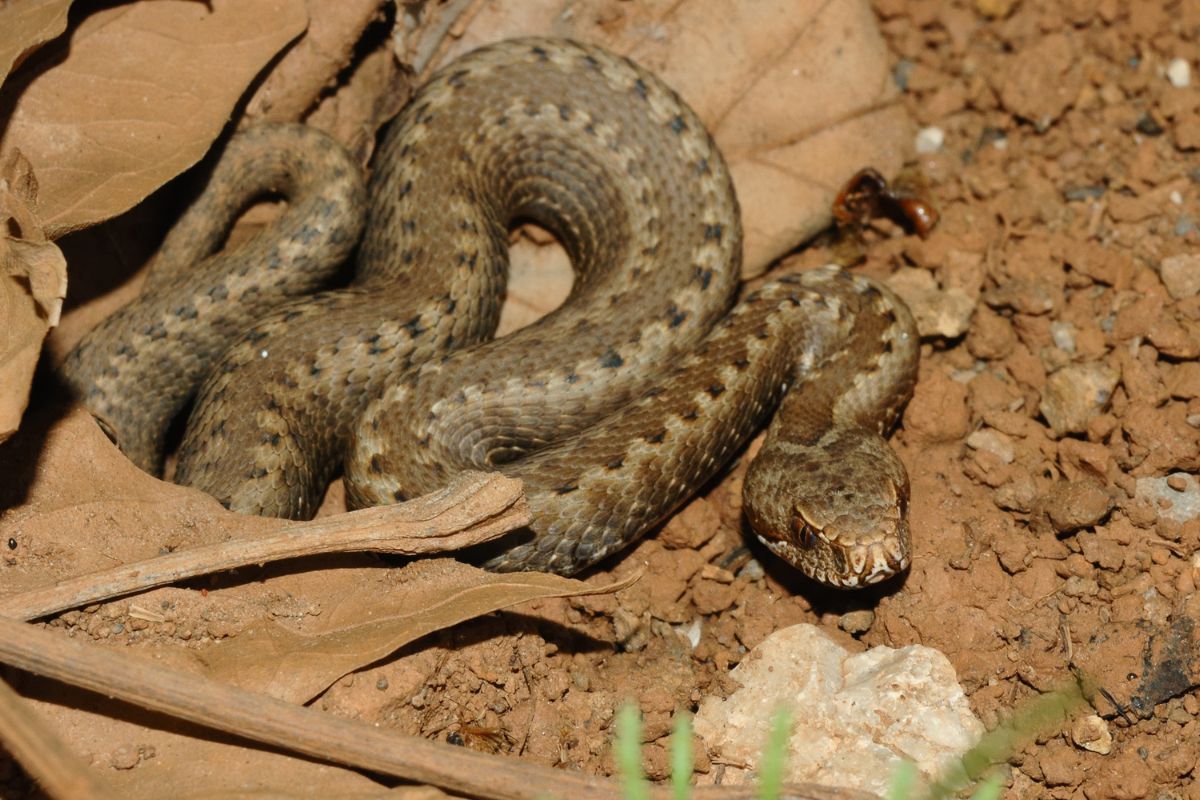
The Viper of Seoane is a very important one to know about. This snake is most commonly found in Northern Spain, and they are also found in Portugal and some parts of France.
They are most commonly found in the mountain ranges in the Northern parts of Spain.
There are lots of different variations of this viper so spotting them can be quite difficult. It is important to know the most common variations of these snakes.
One variation of the snake has a brown zigzag pattern down the back of the snake. The snake itself is usually beige.
Another variation has two brown lines that spread down the length of the snake’s back. The third variation is brown all over the body.
The Viper of Seoane is fairly short, at only half a meter. These snakes can be more dangerous in certain areas than others, and they are believed to be the most venomous in the Cantabrian mountains.
How Dangerous Is The Viper Of Seoane?
If you come into contact with this snake and are bitten by one, it is very important to seek medical attention immediately.
While these snakes rarely cause fatalities, they can cause problems if they bite a very young or a very old person.
Montpellier Snake (Malpolon Monspessulanus)
This snake is commonly found in Spain, France and Portugal. It is also found in Northwest Africa.
It is the most common snake in Spain, and it is mildly venomous. You will find this snake in heathland and shrubland as well as in urban areas.
This snake grows to a larger size than the other snakes on this list as it can reach up to two meters in length. It can be found in lots of different colors.
The scales are either green, gray, brown, black or metallic. They have a large eye with a very prominent brow above it.
If the Montpellier snake feels like it is being threatened it will raise its head and hiss at you, so make sure that you back off if you hear that sound.
It is not common to be bitten by this snake as their fangs are in the back. You will likely be bitten if you are handling the snake, though, so stay away!
How Dangerous Is The Montpellier Snake?
The Montpellier snake is not deadly if you get bitten by it. If you are bitten by this snake, you may experience stiffness, swelling, and numbness.
You may even experience mild fever, however, these symptoms will usually pass in a few hours.
If you do get bitten, it is a good idea to get some medical attention. While the symptoms usually pass you should get yourself checked out to be on the safe side.
Viper Of Lataste (Vipera Latastei)
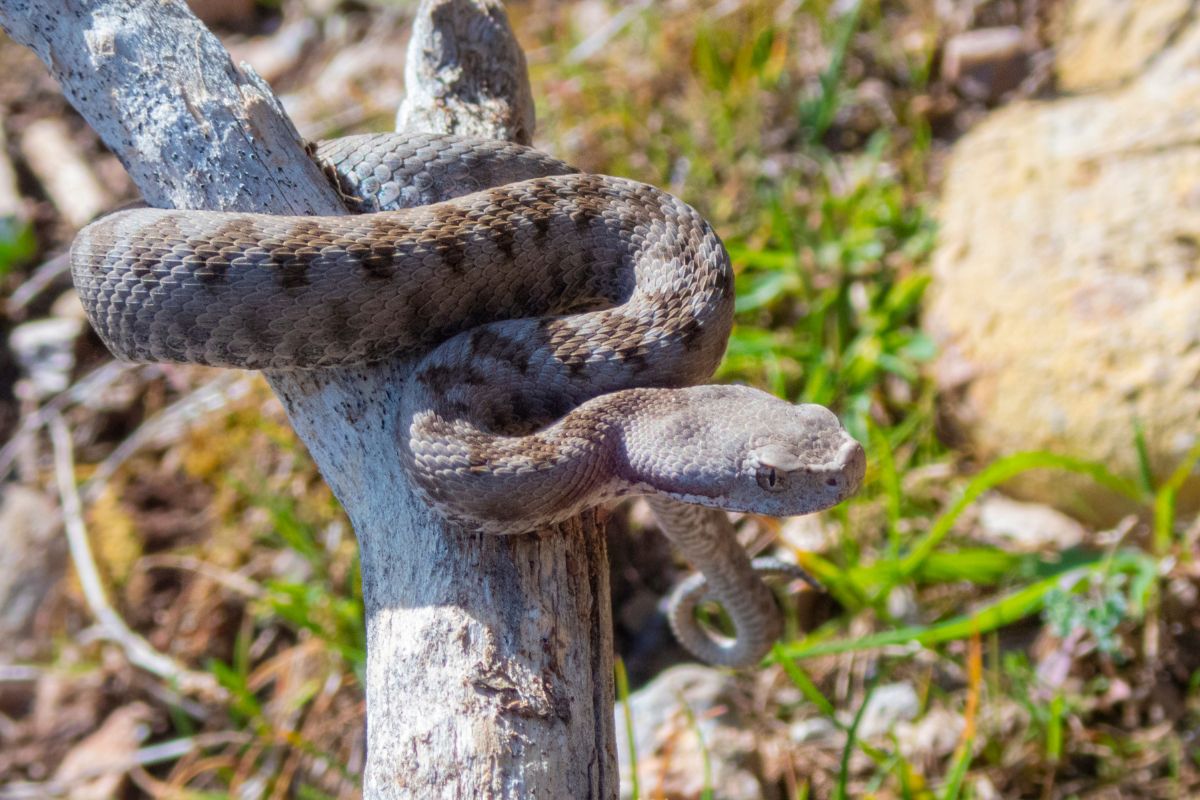
The Vipera Latastei is usually found in Northwestern Africa. In Spain, this snake is commonly found in rocky areas, usually in shrubland. You will find the snake in woodlands.
This snake is very recognizable as it has a triangular head. It is dark-colored, with a zigzag pattern. It is a short and thick snake, usually no longer than 60cm in length.
The snake will likely run away if it is approached, so it is very unlikely that you will be bitten by the snake, however, if you do it can be very dangerous.
How Dangerous Is The Viper Of Lataste?
The Vipera Latastei is a very dangerous snake. If you are bitten by this snake, the snake bite can be fatal.
It has necrotic effects on humans. This is because the venom of this snake contains hemotoxin. This can cause tissue damage and it can interfere with the way in which your blood clots.
This can cause organ damage and tissue damage in the areas surrounding the bite.
If you are bitten by this snake, you should seek medical help as soon as possible. If you are young, old or suffer from allergies you are most at risk.
Asp Viper (Vipera Aspis)
This snake is often found in Southwestern Europe. It grows up to 60-65 cm in length. While the snake varies greatly between subspecies, the subspecies that is most commonly found in Spain has a triangular head and an upturned nose.
You will find this snake on hills or low mountains. It is more commonly found in limestone regions and it is often found undercover. It is often found in rubbish dumps and shrublands near mountains.
How Dangerous Is The Asp Viper?
This snake is the most dangerous snake in Spain. If you are bitten by this snake you need to seek medical attention immediately. 4 percent of people bitten by this snake will not survive.
If you are bitten by this snake you will experience swelling, discoloration. You will experience necrosis within 2 hours of being bitten.
Non Venomous Snake
There are also some non venomous snakes in Spain to keep an eye out for.
Viperine Water Snake
This snake is commonly found in lakes and rivers. It is commonly seen in certain areas so if you keep an eye out for it you are likely to catch a glimpse of one. It is a harmless snake so you don’t have to worry about being bitten by it.
These snakes eat fish and they are not aggressive. It is very uncommon to be bitten by them. The snake is 85cm in length and is found across Portugal, Spain, France and Italy.
These snakes are either brown, red or gray. They have a zigzag stripe on them and usually have a yellow or red stomach.
Horseshoe Whip Snake
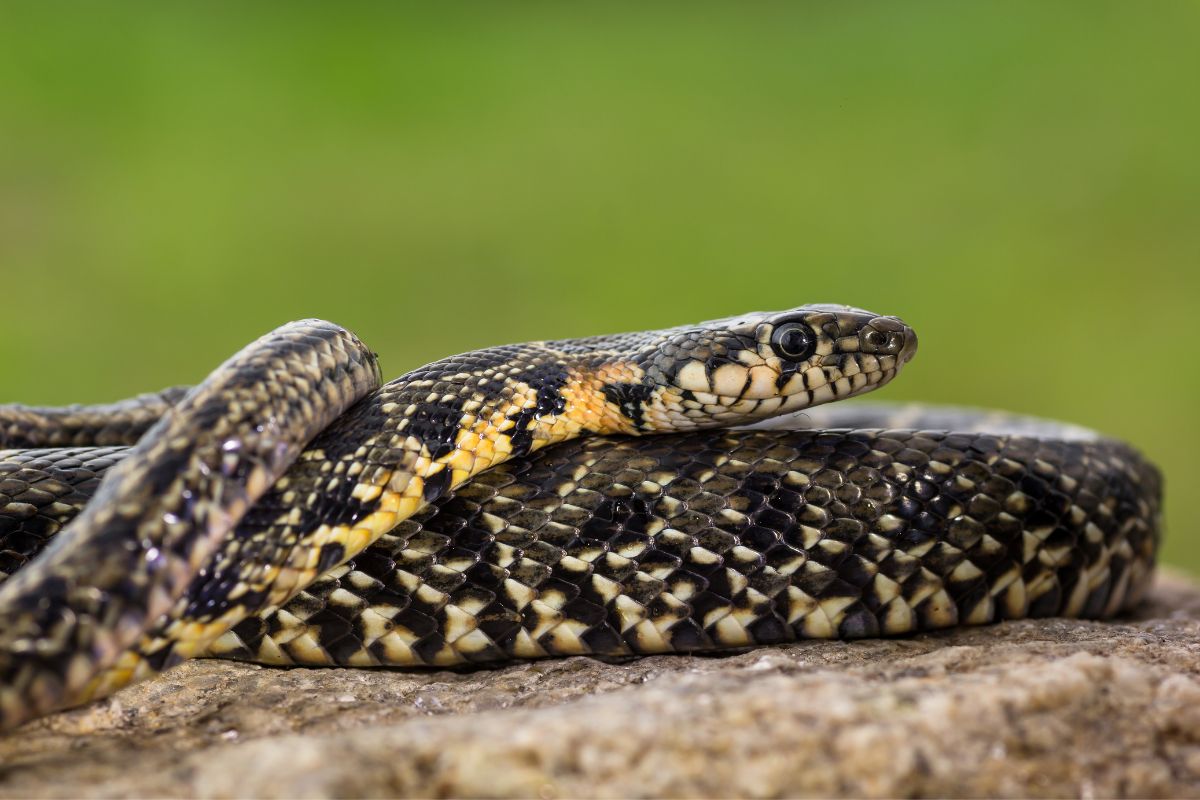
This snake is not very dangerous at all. It is a very impressive snake that will not cause you any harm if you come into contact with it.
It is most commonly found in Southern Spain. You will also find these snakes across central Spain, North Africa and Portugal.
You can spot this snake very easily as it has a very large head. It is a dark color and it has a pattern on the skin that looks like a chain.
It will grow up to 180 cm in length so it is quite long. It is also a fairly fast snake but it is not harmful.
They are most likely to be found in dry mountains that are covered with scrub as well as cultivated buildings.
Aesculapian Snake
This snake is a non venomous snake that you will find across Europe. It is bronze in color and it is quite metallic. The snake is usually found in hot environments and in Spain they can be found in gardens and sheds.
These snakes will bite if they are threatened but their bite is not venomous. They will also intimidate their opponent when they feel threatened by moving their mouth.
Ladder Snake
This is a very common snake in Spain. If you provoke this snake they are likely to attack you, however you will not be in any danger. You will just be left with a bite that can be quite painful.
The Ladder Snake can be found in orchards, vineyards and hedges and it will usually eat things like mice and rabbits.
This snake can be up to 160 cm in length. It has a distinctive snout and is either brown or yellow in color. It also has two darker stripes along its body. The ladder snake is able to climb up trees and buildings.
If the Ladder snake is threatened it will react by hissing and lunging forwards. It could bite you, especially if you try to pick it up, so stay as far away as possible if this happens!
Southern Smooth Snake (Coronella Girondica)
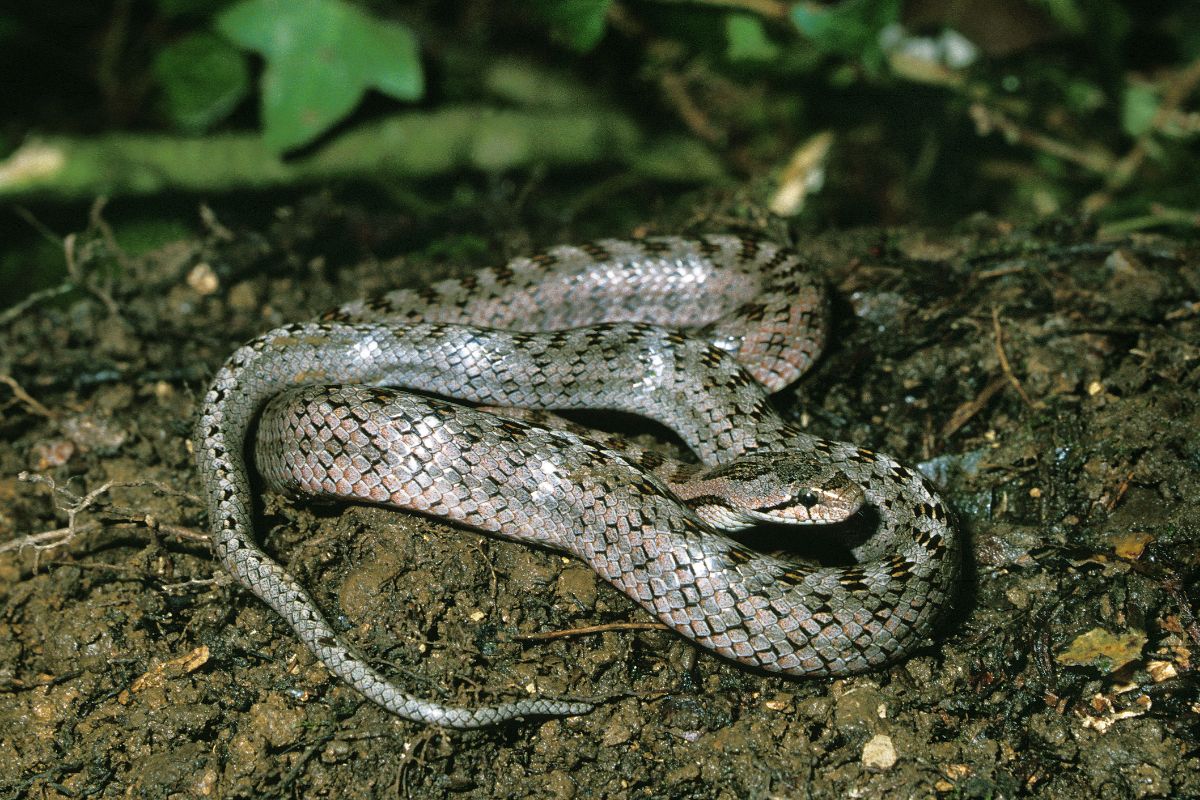
The Southern Smooth Snake is not a venomous snake and it can be found in Southern Europe and Northern Africa.
These snakes are fairly small, measuring up to 60cm. They have a small, flat head and their neck is marked.
You will find these snakes in Spain between March and November. They are very slow snakes and you will not see them climbing much.
These snakes have a red ring around their pupils so they are quite distinctive. The color of this snake varies. They can sometimes be brown and sometimes they will be gray.
The Southern Smooth snakes can be found in scrub lands, woods and on rocky hillsides. They are usually spotten in the evenings rather than in the daytime and they are seen as very elusive animals.
These snakes feed on small lizards and small snakes. They will usually catch their prey by constricting them.
Green Whip Snake (Hierophis Viridiflavus)
This Green Whip snake is fairly harmless. It is non venomous and very small in size. While these snakes are harmless, they will bite you if they are cornered.
It has smooth scales and prominent eyes. The snakes’ preferred habitats are forests and shrubland and they feed on lizards, mice and small birds.
Grass Snake (Natrix Natrix)
The Grass snake is another snake found in Spain that is non-venomous. This snake will be found near water as it usually feeds on amphibians.
The Grass snake is usually dark green or brown and it has a yellow collar. This snake lives in lots of different places across Europe but it is also commonly found in Northwest Africa and the Middle East.
Grass snakes live near water but they don’t always need the water. They can be aggressive when they are threatened however they don’t often bite. Instead, they threaten by hissing.
Frequently Asked Questions
How Many Species Of Snake Are There In Spain?
There are somewhere between 12 and 15 species of snake in Spain. Only 5 of these snakes are venomous. If you are bitten by any of the venomous snakes in Spain you should seek medical attention immediately.
It is very important to make sure that you don’t leave it too long as some of the snake bites can be fatal.
There are between 7 and 10 other species of snake that are not venomous. These snakes may bite you but they will not cause long term harm, instead just causing a slightly painful bite.
What Should You Do If You Come Into Contact With A Snake In Spain?
You should make sure that you stay away from the areas where snakes are commonly found.
It is important that if you do encounter a snake, you remain calm. The best thing to do is to move away from the snake in order to avoid getting bitten by the snake.
If you or someone else in your group get bitten by a snake the best thing to do is to speak to a medical professional immediately. You should call the ambulance immediately if there is no one to talk to nearby. The number for an emergency in Spain is 112.
If you can safely do so you should take a photo of the snake so that the medical professional can determine the species to work out whether or not it is venomous.
While you wait for the ambulance to arrive you should limit the movement in the person who has been bitten. This will stop the venom from spreading further.
Are You Likely To Die From A Snake Bite In Spain?
Snakes are fairly common in Spain, however it is very unlikely to die from a snake bite in the country. In Spain there are between 3 and 6 deaths caused by snake bite each year so the odds of death by snakebite are very low.
The odds of death by snakebite in Europe are also very low with only 50 people dying each year.
You are at a higher risk of dying from a wasp or bee sting than of dying by snakebite, and the odds of this happening are also very low.
You are also very unlikely to experience a snakebite at all as they are quite rare in Spain. As long as you stay away from the snakes and the areas that they will likely be then you are very unlikely to suffer from a snakebite.
Final Thoughts
If you’re planning a trip to Spain the last thing you want is for it to be ruined by a snake bite. This article explores everything you need to know about snakes in Spain. Read this before you travel and you will have all the information that you need.
There are 5 venomous snakes to be wary of in Spain, and they are detailed in this article. If you encounter a snake make sure that you stay away from it. If you do get bitten, seek medical attention immediately.
- GOOD TO KNOW BEFORE YOU GO!Dublin, Ireland - August 3, 2023
- What Are The Most Popular Wineries For Views And Tastings On Seneca Lake? - January 3, 2023
- When Should You Visit Japan? Check Out The Best Times To Enjoy The Snow - January 3, 2023


